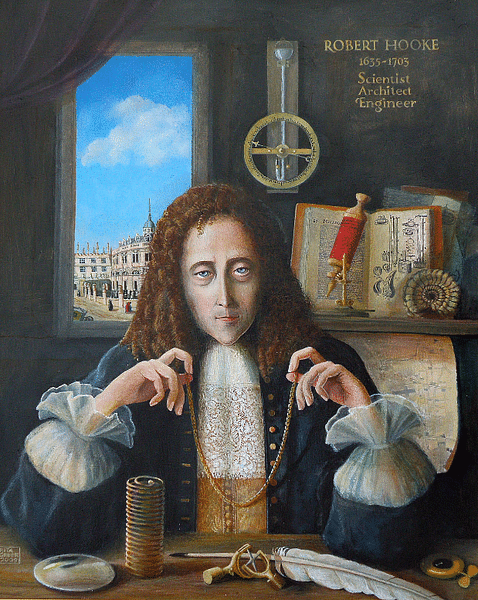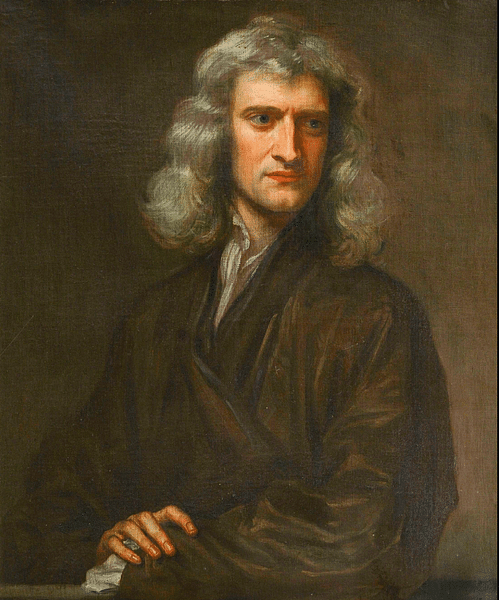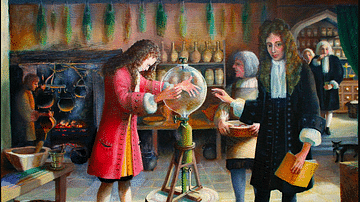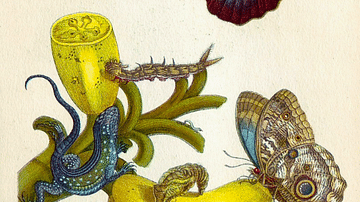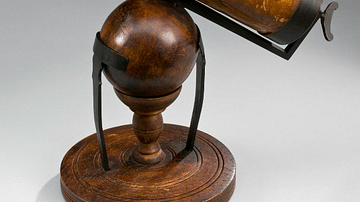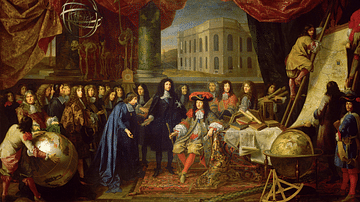The Royal Society was founded in 1662 to promote scientific research and increase our knowledge of the natural world. With royal patronage and a stellar membership of great minds, the society quickly gained international recognition for its work. One of the society's noted presidents in its formative years was Sir Isaac Newton (1642-1727), who held the post for 27 years.
Newton was also responsible for one of the great feuds that beset the society, unfortunately not an uncommon state of affairs, as great men competed for credit as the first to make certain scientific discoveries. More positively, in many ways, the Royal Society was responsible for setting out what exactly we consider science today, with its emphasis on experimentation, sharing of data and knowledge, and having peers critically assess all new results and theories.
Origins of the Royal Society
The idea of the Royal Society is often credited to the English statesman and philosopher Francis Bacon (1561-1626). In Bacon's New Atlantis (published incomplete in 1626), he presented the idea of a utopian scientific institution that promotes research; he called it Salomon's House in homage to the wisdom of the Biblical King Solomon. Three decades later, in 1660, several natural philosophers, that is thinkers and men of science who sought to explain the physical world around us, men who had already met each other from time to time in informal settings, got together to make Bacon's idea a reality. There were other such informal groups in other areas of studies, particularly as at that time, the universities largely concentrated on teaching and did not conduct research like today. In order to more efficiently discover and promote new ideas, the benefits of a formal institution were required. In addition, such a self-funding institution would mean scientists (perhaps more accurately described back then as natural scientists) did not have to go around begging for financial support from wealthy patrons inclined to pursue their own interests rather than those of science as a whole.
Purpose of the Royal Society
Our group of thinkers formed a permanent and formal group that might share and advance knowledge, particularly in mathematics, physics, and what was then called ‘experimental philosophy' as opposed to the more traditional and theoretical natural philosophy that had previously dominated great minds in Europe. Sharing knowledge had been a key component of Bacon's philosophy. The first gathering took place in 1660, the year of the Restoration, which saw the return of the institution of monarchy with Charles II of England (r. 1660-1685) as king. Charles took a keen interest in science and gadgets; he even had his own personal laboratory in Whitehall Palace. On 15 July 1662, Charles issued a royal charter to the body of thinkers, and so it became The Royal Society of London for Improving Natural Knowledge, more commonly referred to as simply the Royal Society. It was formed as a public body with the formal aim of promoting research in the field of science. Although it had the royal seal of approval, the society received no funding from the state and so could conduct its affairs entirely independently. The royal charter did give more than just prestige to the society since it allowed it, under the protection of English law, to publish its own books and license others to do so, it could correspond with foreigners, and it could own its own property, both in terms of buildings and objects. The Society invested, too, in shares in various joint-stock companies, notably the slave-trading Royal African Company in 1682. In all of these ways, along with a small subscription fee from members, the society generated money to invest in its research.
Society members and fellows were led by an elected president, chosen for one year in office but with no restriction on repeated terms. Qualification to become the president, at least in the early years, was not based on the scientific endeavours of the individual but rather on their vital personal connections. Usually, powerful friends in the realms of politics and high society were considered far more useful than scientific knowledge in order to secure greater fame and finances for the society. In just one example, the president from 1686 to 1689 was John Lord Carberry, who had once been the governor of Jamaica. Reigning in the power of the president and providing day-to-day management, a board of 21 senior fellows met to consider the society's general direction. Required to always consider themselves equals, there was no formal hierarchy of these or the other fellows. Except for a handful of positions which received a salary – mundane roles such as the secretary – fellows received no regular income from their activity with the society, although the costs of some of the more expensive scientific demonstrations were reimbursed. Lengthy meetings of the society were held each Wednesday afternoon at Gresham College in London.
Meetings & Public Role
At the meetings of the society, there were discussions between fellows but also practical demonstrations of new ideas, such as through dissection or the testing of a complex new piece of apparatus. Fellows also kept themselves up-to-date on what scientists outside the society were working on as translated works from across Europe were presented and discussed. Latin was the preferred language of translation, but the universal language of mathematics was even better in the opinion of many fellows. Contrary to the society's founding ideal of freely sharing information, this rarely involved everyone in practice, and a surprisingly large number of thinkers communicated their research to select other fellows using codes, ciphers, and even invisible ink. This secrecy was because many inventors were worried that a rival got one step ahead of them in the game to be the first at a discovery. Others, like Hooke, often wrote in code for no other reason than to weed out the more intelligent readers from those he considered had no right to learn about his discoveries. News and scientific developments also came in via regular correspondence from the society's more intrepid members who literally travelled the world, conducting experiments in such exotic locations as Virginia, Bermuda, St. Helena, and Java.
The society created its own museum in London, which was open to the public. The museum became very popular, showing off weird and wonderful artefacts like fossils, wax-injected anatomy specimens, examples of avant-garde scientific instruments, exotic mineral, plant, and animal specimens, and all the latest maps and astronomical charts. There were sometimes public demonstrations, but these did not always go to plan because the magnificent men and their science machines were certainly not afraid of taking risks. Even when things went right, honoured guests were sometimes left bemused, such as Margaret Cavendish, Duchess of Newcastle, who, in 1667, had to face "colours, magnets, microscopes, roasted mutton, and blood" (Gleick, 65) on her visit. In contrast to today's sensitivities, 17th-century audiences were most intrigued by the society's frequent vivisections, the exhaustion of countless animals in vacuum jars, and even blood transfusions from sheep to humans.
The Royal Society had its own impressive library and archive of books and manuscripts. Unfortunately, many members abused their privileged access, and book theft was a real problem. An early attempt to have specialised committees dealing with specific branches of knowledge was not a success, but many new and important discoveries were made. Royal Society fellows were responsible for discovering new comets and stars, new improvements were made to such crucial instruments as the telescope, microscope, and air pump, the circulation of blood was finally fathomed, and ever-present phenomena such as gravity, inertia, and the colours of the spectrum were observed and understood. In short, by the end of the 17th century, the Royal Society as a whole was already recognised internationally as a body capable of great scientific endeavour. The early findings of the society were captured in its first history book, the History of the Royal Society by Thomas Spratt.
Membership of the Royal Society
The fellows of the Royal Society included such luminaries as the noted anatomist Robert Boyle (1627-1691), the astrologer, natural philosopher, and diplomat Kenelm Digby (1603-1665), and Henry Oldenburg (d. 1677), editor of the influential magazine Philosophical Transactions (first issued in March 1665), which had close connections with the society but was not its official publication. Samuel Pepys (1633-1703), the great diarist and commentator on English life, was president from 1684 to 1686. There were even figures, at least in the early days, whom we would not associate with science at all, such as the magician Elias Ashmole (1617-1692). It is noteworthy that the very first president, Viscount Brouncker (1620-1684), dabbled in horoscopes when taking a break from mathematics. Even Isaac Newton (and others) experimented in the dubious protoscience of alchemy as these men sought any means whatsoever to further their knowledge. There were, too, some royal members, notably the king himself and his brother James Stuart, Duke of York (future James II of England, r. 1685-1688). Foreign fellows – and there were 72 amongst the first 550 fellows – included two notable Dutchmen, the mathematician, astronomer, and inventor Christiaan Huygens (1629-1695) and the microscopist Antonie van Leeuwenhoek (1632-1723). By the 18th century, one-third of the fellows were foreigners.
In theory, any adult male could join the society and membership was not restricted to nationality or believers of any particular religious denomination. In reality, though, most fellows were also members of the Church of England, particularly the Puritans, since these men had made up the majority of the informal discussion groups during the years of Oliver Cromwell's Commonwealth prior to the restoration of the monarchy. There were some exclusions, too. When Professor William Whiston (1667-1752) was found guilty of heresy, he was refused membership of the society. There were also some atheists, openly so or otherwise, such as the astronomer Edmond Halley (1656-1742).
One became a fellow of the Royal Society upon the approval of the existing fellows. To become a fellow was certainly a prestigious feather in one's cap since not everyone who wanted to got in the club. One notable absentee was the architect, surveyor, and all-round practical scientist Robert Hooke (1635-1703), likely excluded because of his humble family background. Hooke was such a master inventor, though, that he got into the society via a metaphorical side door when he was appointed the Curator of Experiments. The indomitable Hooke became a full fellow in 1663, and he served as the society's secretary from 1677 to 1682, but his case highlights the frequent snobbery amongst these supposedly enlightened individuals.
Subscribing members paid one shilling per term to remain so. Those who lagged behind with their subscription fee could easily find themselves expelled. This embarrassing last resort befell no less a figure than the Royal Astronomer John Flamsteed in 1709. Women were not permitted to join the society or attend its meetings (the only woman to do so before the 20th century was Margaret Cavendish, who, as we have seen, probably wished she had not bothered). The majority of members belonged to at least the upper middle class, but more often than not, they and the fellows were gentlemen of private means. There were some attempts to attract merchants and tradesmen as members since one of the society's goals (unfortunately, rarely realised) was to make its research of economic value in the real world.
Early Problems: The Newton-Hooke Rivalry
As Curator of Experiments (a position he held until 1677), Robert Hooke was instrumental in championing the need for practical experimentation and he pioneered improvements in all sorts of equipment and instruments such as barometers, clocks, pumps, gears, telescopes, microscopes, and various navigational aids. As the historian L. Jardine notes: "A man of resolutely practical bent, his response to any scientific problem was to invent a piece of equipment to resolve it" (44). Despite Hooke's efforts, mathematics and theoretical knowledge still dominated over experimentation and were much more highly regarded by most men of learning. This chasm in the two approaches led to rivalries, most infamously between Hooke and Isaac Newton.
Newton would eventually gain international recognition as one of, perhaps even the great scientist of the Scientific Revolution, but even he found it difficult to gain favour with the Royal Society. Newton had discovered several new aspects of light and optics, but the society politely ignored his research. In order to get the society's attention, Newton invented and made a new type of telescope that used a refracting mirror. This telescope was more powerful and much smaller than other contemporary models, and Newton sent it to the society in 1668, where it was well-received. Now known and in favour, Newton sent along his manuscript on optics to the society for consideration. Mistakenly, since Newton's telescope invention put him in the category of practical inventors, his theoretical work was given not to an expert in that field but to that master of inventions Hooke. Hooke, unable to understand all that was going on in Newton's book, especially the mathematics, dismissed it as requiring more work. As a result, the field of optics made little progress, and Newton was not made a fellow of the Royal Society until 1672, an episode that illustrates how slowly the wheels of power turned in this august yet often cumbersome organisation.
The Hooke-Newton relationship got off on the wrong foot then and never improved, so these two greatest of scientists were forever out of step. The relationship deteriorated further when Hooke accused the notoriously hypersensitive Newton of plagiarising his work on optics and on the inverse-square law of gravity (both charges had no real grounds). The pair also took opposite views of what exactly constituted white light. Newton withdrew from the society following Hooke's accusations, and so began a long and bitter feud. Hooke and Newton drew their own personal followers into the dispute, and so for years, British science and mathematics were fractured into two groups: the Newtonites and the Hookeists, a fault line that wasted much energy and delayed new discoveries. Together, the two men had once helped each other in their work by throwing around ideas and speculations. Hooke had given Newton the grain of an idea when he noted that the discovery by Johannes Kepler (1571-1630) that planets moved in elliptical orbits might be due to a force we now call gravity, but Newton refused to acknowledge any help from anyone, not even in a preface to his works. One would imagine this bouncing around of ideas was one of the key advantages of society fellows regularly meeting in Gresham, but sadly, the great minds of the society were often all too human in their relationships.
The Newton Presidency
Newton took over the presidency of the Royal Society in 1703 (significantly, it was the year Hooke died) and then proceeded to systematically remove as many references to his rival as he could over the next 24 years. Newton's presidency revived the rather flagging society both in spirit and finances, although his infamous high opinion of himself was evident in his insistence the royal mace be present in the room whenever he presided over a meeting and removed if he were absent. A major benefit of Newton's presidency was that he promoted experimentation – ironically Hooke's approach – amongst the society's members, encouraging them to move away from the habit of merely reading each other's manuscripts and those of thinkers elsewhere at home and abroad. Certainly, the tradition of the Royal Society became one of collaboration – despite the clashes of personality – where scientists gathered together the data they and others had collected in order to make their conclusions more convincing.
Into the Future
The Royal Society's work crossed international borders. The Royal Academy of Sciences in France was founded in 1666, and some scientists belonged to both organisations (Newton became the first foreign member of the French Academy of Science in 1699). This cross-membership further increased the opportunities for international cooperation. Other august bodies with contacts in the Royal Society included the Academia del Cimento in Florence (f. 1657), the Berlin Academy (f. 1700), and the St. Petersburg Academy (f. 1724). None of these societies, though, were financially independent like the Royal Society since they relied on state funding, and most were much more elitist in their membership.
The Royal Society continues its work today, promoting scientific education and research and so fulfilling the motto agreed upon by its original founders: Nullius in verba or Do not take anybody's word for it or Words are not enough. This approach to what we would today call modern science: endlessly and independently testing ideas through practical experiments, emphasising communication, promoting independent critical review, and avoiding any secrecy, is perhaps the most enduring legacy of those who founded the Royal Society over 350 years ago.



